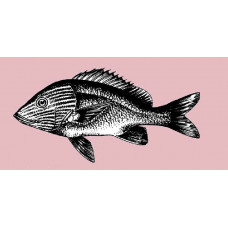Latin name
Haemulon plumieri
Other names
Redmouth; Spanish: ronco margariteño.
Identification
The body is tall, flattened from the sides. The head is large, massive: its profile from the end of snout to eyes is only just visible concave. The snout is sharpened, the mouth is terminal, large - the upper jaw reaches the middle of the eye. The dorsal fin is almost continuous, with a small notch between the barbed and soft parts. Above the lateral line, the scales are larger than below it. One of the most colorful grunt, it has a silvery gray body with a moderate yellow stripe on the body and numerous blue and yellow stripes on the head. The scales may have a bronze cast and create a checkered pattern. The inside of the mouth is red. It has 12 dorsal spines and 15 to 17 dorsal rays, 8-9 anal rays and 17 thoracic rays.
Distribution
Occurs from the Chesapeake Bay to Brazil, including Bermuda, the Greater and Lesser Antilles, the Gulf of Mexico, the Caribbean Sea.
Habitat
White grunts prefer shallow waters from coastal to outer reef areas. The young lead a pelagic lifestyle, but after 9 months they descend to greater depths.
Size
Average length and weight are 8 to 14 inches and about a pound, although white grunts can reach 25 inches and weigh 8 pounds. They live up to 13 years.
Life history and Behavior
This species is a schooling fish, often found in large groups. Schools move in the shade during the day and are frequently located along the edges of reefs and at the base of coral formations. Sexual maturity occurs at about 10 inches, and spawning occurs in the southeastern United States in late spring and summer. Juveniles spend the first 9 months of their lives in the pelagic zone and then transition to a benthic lifestyle.
Food and feeding habits
They are bottom feeders that roost in the sand and bottom soil near reefs. They feed on crustaceans, marine worms, as well as mollusks and small fish. The food composition varies depending on the habitat and reflects zonal differences in the food base.
Reproduction
Spawning occurs in portions. Off the coast of Cuba it lasts 8 months, from October to March (with a break in June-September); on the Bank of Campeche - from May to August; off the coast of Florida spawning concentrations form in May, and spawn in June; in Jamaican waters mature fish are observed in January-April, in Puerto Rico - in February-April and September-November. The fish mature at the age of 2 years.
| Classification | |
| Phylum | Chordata |
| Class | Actinopterygii |
| Squad | Perciformes |
| Family | Haemulidae |
| Genus | Haemulon |
| Species | H. plumieri |
| Features | |
| Conservation status | Least Concern |
| Habitat | Littoral |
| Life span, years | 13 |
| Maximum body weight, kg | 3.63 |
| Maximum length, cm | 63.5 |
| Sailing speed, m/s | No information |
| Threat to people | Edible |
| Way of eating | Bentophage |




